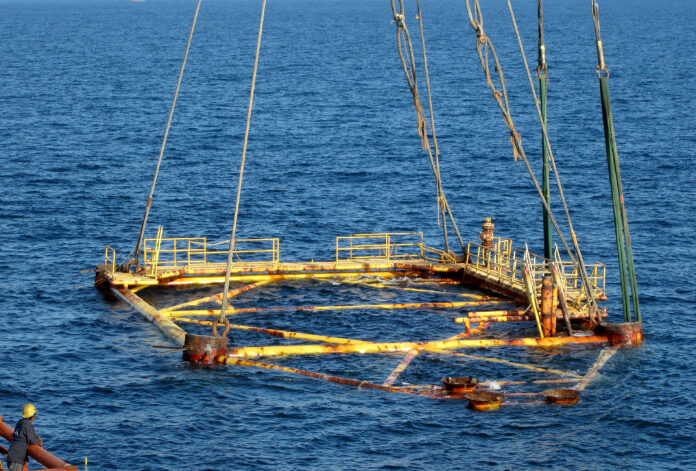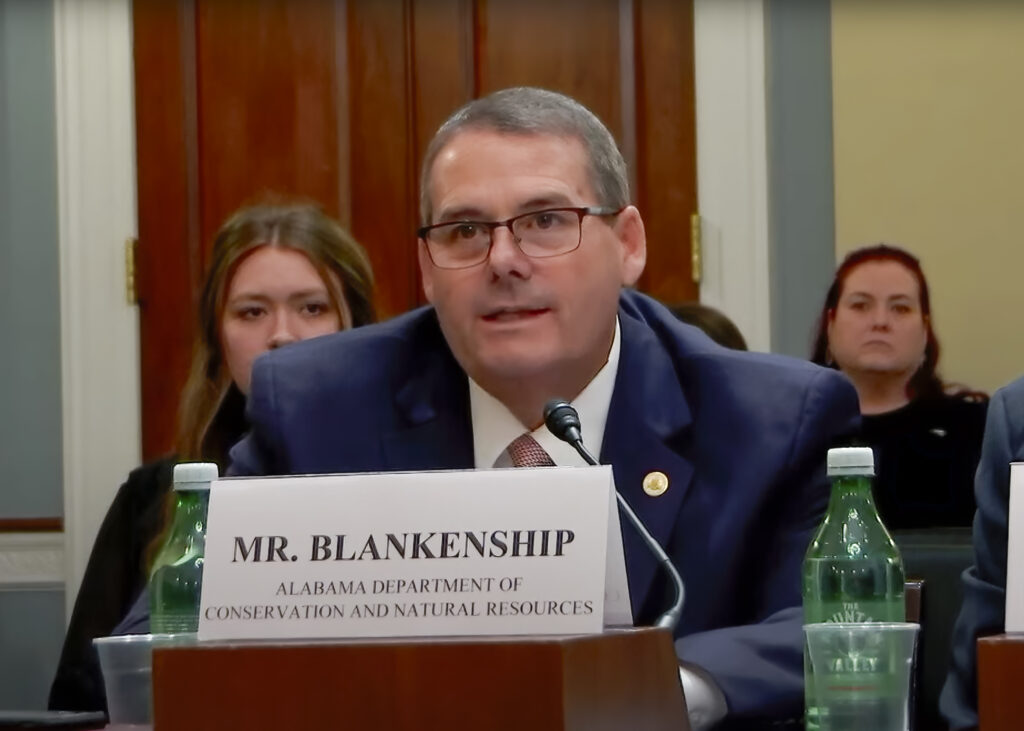
MONTGOMERY, Ala. – At the request of Alabama Representative Jerry Carl (R) and the House Natural Resources Committee, Conservation Commissioner Chris Blankenship traveled to Washington, D.C., recently to testify about the crucial funding Alabama receives from oil and gas leases through the Gulf of Mexico Energy Security Act (GOMESA). Commissioner Blankenship highlighted how the GOMESA funding positively affects the Alabama Gulf Coast’s resiliency and quality of life.
Congressman Carl said Commissioner Blankenship’s vast knowledge of Alabama’s coastal resources and conservation initiatives would provide the U.S. House of Representative’s Committee on Natural Resources with valuable insight on the impact of funding derived from oil and gas leases.
“It’s always a pleasure to have an Alabamian here in Washington,” Congressman Carl said. “Today, we’re fortunate to have Commissioner Chris Blankenship join us. With a wealth of experience since 1994 in the (Alabama) Department of Conservation and Natural Resources (ADCNR), he’s our go-to source for all things regarding natural resources and conservation. He will be diving into the nitty-gritty of the GOMESA funding and how it has a critical impact on Coastal Alabama projects, particularly in the underserved communities. Think water quality, public boating access and shoreside enhancement of parks, a true game-changer. Commissioner Blankenship will shed light on the challenges, like the GOMESA cap and the minimum proposed lease sales the next five years, affecting funding for both GOMESA and the Land and Water Conservation Fund project.”
The U.S. Department of the Interior’s 2024-2029 National Outer Continental Shelf (OCS) Oil and Gas Leasing Proposed Final Program significantly limits offshore oil and gas lease sales with only three potential sales in the Gulf of Mexico planning area and no new lease sales in Alaska.
For the first time there will be a two-year gap in leasing plans. Also, for the first time since 1958, no gas and oil lease sales will occur during the current calendar year. These revenues play an important role in various state conservation efforts and also provide funding for outdoor recreational access, hurricane protection and coastal infrastructure improvements while contributing to the Great American Outdoors Act.
Commissioner Blankenship, who was appointed to his position by Alabama Governor Kay Ivey in 2017, thanked the Committee for the opportunity to explain the positive impacts the Gulf of Mexico Energy Security Act of 2006 has had on our beautiful state. He explained that ADCNR is the state agency charged with leasing state water bottoms for exploration, development and production of oil, gas and other minerals and coordinating with the federal agencies on OCS activities.
“I grew up on Dauphin Island,” Commissioner Blankenship said. “Most all my life, we have had production from natural gas wells right off the shores of the island. Many of my friends I grew up with work in the oil and gas industry. Those good-paying jobs are an economic engine for coastal towns. The views of the platforms and work boats during the day and the amber glow of the lights of the rigs at night are a familiar sight from my hometown.”
Commissioner Blankenship testified that the amount of GOMESA revenue received is based on several factors and fluctuates annually.
“In years when lease sales have occurred, the distributions to Alabama through GOMESA revenue sharing are generally 50% higher than in years with no lease sales,” he said. “Since the Phase II revenue sharing formula was implemented in 2017, Alabama has received approximately $227 million. Just last year, we received almost $50 million to do good work!
“The GOMESA projects we have funded in Alabama have had a great impact on improving public access to our waterfront, increasing boating access to our waterways, creating some special places for outdoor recreation, improving coastal water quality, and providing critical scientific information that is needed to better protect and preserve Mobile Bay and the Gulf of Mexico and their tributaries.”
Commissioner Blankenship said outdoor recreation, especially recreation on the waterfront, is a huge part of the quality of life in coastal Alabama, and the projects funded by GOMESA include 15 shoreside waterfront public access and park improvement projects that will enhance the enjoyment that our residents and guests, with and without boats, experience on the waterfront and in the great outdoors.
“I am most proud of the commitment we have made to provide boating access using GOMESA and other funding,” he said. “GOMESA has funded 18 boating access projects in communities of diverse economic situations and will serve all our citizens, no matter their zip code.”
Commissioner Blankenship pointed out that undeveloped waterfront property availability is shrinking rapidly along the coast, making acquisition for parks and public access even more important.
“Governor Ivey has approved seven land acquisition projects that will create public water and recreation access in our two coastal counties (Mobile and Baldwin),” he said. “One project I would like to highlight is the Mobile Bay Western Shore Acquisition with 1,400 feet of bayfront. This is some of the last remaining undeveloped land that will provide public access along Mobile Bay. This project leverages the National Fish and Wildlife Foundation funded Saltaire Nature Preserve Project to really create a special large park space for Mobile County. This project is just one example of how we can use GOMESA in conjunction with other funding sources to do special and long-lasting work.”

Commissioner Blankenship was among five speakers to address the House Committee. (ADCNR)
Commissioner Blankenship said the growth of Alabama’s coastal population is stressing the sewer and stormwater systems, and numerous utilities in coastal Alabama will use GOMESA Funds to undertake sewer improvements or convert septic systems to sewer treatment to improve water quality.
He also said GOMESA funding will strengthen the new School of Marine and Environmental Sciences at the University of South Alabama and increase the research capacity of its Healthy Ocean Initiative.
“The school is a great asset to coastal Alabama and will train students to improve our fisheries and coastal processes for generations to come and will provide critical scientific data needed to better manage our marine resources,” Commissioner Blankenship said. “Alabama is also funding the construction of a top-notch large research vessel for the Dauphin Island Sea Lab, an internationally recognized consortium of universities focused on marine science. This vessel will allow scientists to do a myriad of good scientific work on and off the Continental Shelf providing information and data we have never previously had to inform management decisions.
“All of these projects will have a positive impact in coastal Alabama and add to our already wonderful coastal quality of life. I look forward to working with Governor Ivey to fund similar projects in future years.”
Commissioner Blankenship said Governor Ivey and the State of Alabama understand the critical importance of OCS oil and natural gas production to our economy and national security.
“We have long supported a balanced and reasonable leasing program that leads to the prudent and safe exploration, development and production of OCS hydrocarbon resources,” Commissioner Blankenship said. “The total of three lease sales in the recently published 2024-2029 five-year program is the lowest for any offshore five-year leasing program to date.
“The lack of lease sales will most definitely negatively impact the short-term revenues the State of Alabama will receive through GOMESA revenue sharing. Compounding this short-term loss of revenue, having fewer wells in operation in the Gulf of Mexico, due to limited lease sales, will impact production in future years and will have a compounding negative impact on revenue sharing moving forward. This lack of fiscal resources will impede our ability to fund beneficial long-term projects in coastal Alabama. This hit is on top of the loss of jobs and business infrastructure related to oil and gas exploration and production in the northern Gulf of Mexico due to fewer operational wells.”
Commissioner Blankenship said the successful development of the Gulf of Mexico OCS clearly demonstrates that responsible offshore oil and gas development can generate many good-paying jobs, spur activity in a host of associated industries and generate billions of dollars in revenue.
“We strongly urge the Administration to support existing revenue sharing with the four participating Gulf states, as well as any legislative efforts to expand and enhance such revenue sharing,” he said. “Further, I believe that the existing revenue sharing cap for the Gulf States under GOMESA should be lifted, thus ensuring a more equitable system to share the benefits of offshore development with the affected states. Although the current system of limited revenue sharing utilized in the Gulf of Mexico provides state governments with some resources to expand coastal management and conservation as well as build new docks, boat ramps, parks, and other necessary infrastructure and expand other public services, I firmly believe that expanded and enhanced revenue sharing and a return to more normal leasing opportunities will allow states to more properly address the coastal impacts of offshore production and put them in better position to support OCS activities.
“The GOMESA program and OCS exploration and production is of utmost importance to the people and the coastal economy of the State of Alabama.”
Congressman Carl was instrumental in adding language to H.R. 1 that would revise the formula used to distribute revenue generated from federal oil and leases in the Gulf of Mexico. Specifically, it increases the share of revenue given to the four Gulf producing states (Alabama, Louisiana, Mississippi, and Texas). In addition, this section would eliminate the cap on GOMESA revenue sharing. H.R. 1 has passed the House of Representatives and awaits action in the United States Senate.
Louisiana Rep. Garrett Graves has introduced the BRIDGE Production Act (H.R. 5616) that would require the Department of Interior to hold 13 lease sales in the Gulf of Mexico and Cook Inlet in Alaska during the 2024–2029 time span instead of the current plan.
In written testimony submitted to the Committee, Commissioner Blankenship emphasized how the oil and gas industry contributes to the thriving offshore aquatic populations through the Rigs to Reefs Program. Alabama has the largest artificial reef program in the United States, which helps popular reef fish species, like the iconic red snapper, thrive.
“The largest reefs in our Artificial Reef Program come from decommissioned oil and gas platforms,” Commissioner Blankenship said. “While the rigs are in production, they are called ‘Islands of Life’ as they act as artificial reef structures in the Gulf of Mexico. The habitat created by these rigs in the entire water column, from surface to seabed, is incredible. Organisms of all trophic levels benefit from the structure and marine growth on the platform legs and supports. These ecosystems develop and grow over the many years these platforms are in the water. The thousands of platforms in the Gulf have created untold benefits.
“Many times, in the discussions on the pros and cons of OCS production, the positive benefit the rigs have on habitat creation and marine populations, as well as recreational and commercial fishing opportunities, is lost in the conversation. This is a huge benefit to our marine resources and the people who enjoy them!”
Alabama has reefed in place several decommissioned oil or gas production platforms over the past several decades to keep these “Islands of Life” in the state’s marine resources production.
“I have never visited one of these reefs when I didn’t see a sea turtle, shark, or dolphin enjoying the benefits of this protected habitat,” Commissioner Blankenship said. “It has long been Alabama’s policy that our support for offshore development is contingent on all OCS activities in waters adjacent to our coast being carried out in full compliance with relevant Alabama laws, rules and regulations and in a manner that is fully compliant and consistent with our Coastal Zone Management Program.”




















